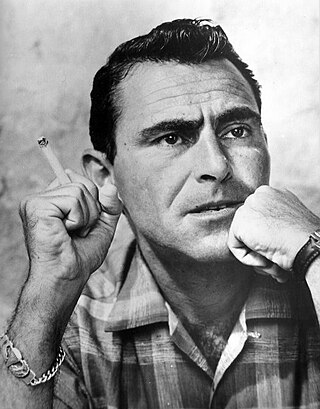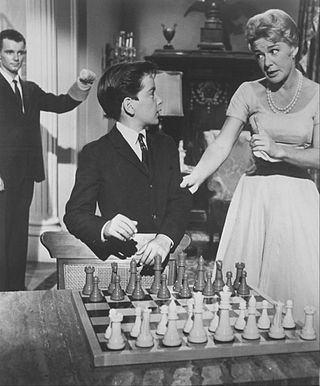Related Research Articles

The Twilight Zone is an American media franchise based on the anthology television series created by Rod Serling in which characters find themselves dealing with often disturbing or unusual events, an experience described as entering "the Twilight Zone". The episodes are in various genres, including fantasy, science fiction, absurdism, dystopian fiction, suspense, horror, supernatural drama, black comedy, and psychological thriller, frequently concluding with a macabre or unexpected twist, and usually with a moral. A popular and critical success, it introduced many Americans to common science fiction and fantasy tropes. The first series, shot entirely in black-and-white, ran on CBS for five seasons from 1959 to 1964.

Rodman Edward Serling was an American screenwriter and television producer best known for his live television dramas of the 1950s and his anthology television series The Twilight Zone. Serling was active in politics, both on and off the screen, and helped form television industry standards. He was known as the "angry young man" of Hollywood, clashing with television executives and sponsors over a wide range of issues, including censorship, racism, and war.

Armstrong Circle Theatre is an American anthology drama television series which ran from June 6, 1950, to June 25, 1957, on NBC, and from October 2, 1957, to August 28, 1963, on CBS. It alternated weekly with The U.S. Steel Hour. It finished in the Nielsen ratings at number 19 for the 1950–1951 season and number 24 for 1951–1952. The principal sponsor was Armstrong World Industries.

The Twilight Zone is an American fantasy science fiction horror anthology television series created and presented by Rod Serling, which ran for five seasons on CBS from October 2, 1959, to June 19, 1964. Each episode presents a standalone story in which characters find themselves dealing with often disturbing or unusual events, an experience described as entering "the Twilight Zone", often with a surprise ending and a moral. Although often considered predominantly science-fiction, the show's paranormal and Kafkaesque events leaned the show much closer to fantasy and horror. The phrase "twilight zone", inspired by the series, is used to describe surreal experiences.
Julius Caesar Bass was an American director, producer, lyricist, composer, and author. Until 1960, he worked at a New York advertising agency, and then co-founded the film production company Videocraft International, later named Rankin/Bass Productions, with his friend, Arthur Rankin Jr. He joined ASCAP in 1963 and collaborated with Edward Thomas and James Polack at their music firm and as a songwriting team primarily with Maury Laws at Rankin/Bass.

City Hospital, one of the first medical dramas on American television, was broadcast from 1951 to 1953, first on ABC and later on CBS.
The Doctor is a half-hour American medical anthology series that aired Sunday evenings on the NBC television network from August 24, 1952, until June 28, 1953, with a total of 44 episodes.
Mackenzie's Raiders is an American Western television series starring Richard Carlson that was broadcast in syndication and produced in 1958–1959. The series is narrated by Art Gilmore, and was produced by Ziv Television Programs.

Martin Ellyot Manulis was an American television, film, and theatre producer. Manulis was best known for his work in the 1950s producing the CBS Television programs Suspense, Studio One Summer Theatre, Climax!, The Best of Broadway and Playhouse 90. He was the sole producer of the award-winning drama series, Playhouse 90, during its first two seasons from 1956 to 1958.

Patricia Rose Breslin was an American actress and philanthropist. She had a prominent career in television, which included recurring roles as Amanda Miller on The People's Choice (1955–58), and as Laura Harrington Brooks on Peyton Place (1964–65). She also appeared in Go, Man, Go! (1954), and the William Castle horror films Homicidal (1961) and I Saw What You Did (1965).

The Betty Hutton Show is an American sitcom that aired from October 1, 1959, until June 30, 1960, on CBS's Thursday schedule. The show was sponsored by General Foods' Post Cereals, and was produced by Desilu and Hutton Productions.

TV Reader's Digest is the title of a 30-minute American television anthology drama series, which aired on ABC from January 17, 1955, to July 9, 1956. Its theme music was "Polonaise" from Act III of Eugene Onegin.
Steve Randall is an American detective television series starring Melvyn Douglas. The series' 13 episodes were initially seen in syndication during the summer of 1952, before being picked up and rerun by the DuMont Television Network from November 7, 1952, to January 30, 1953. CBS subsequently ran 9 of the same 13 episodes again from June 16, 1953, to August 11, 1953.
Starlight Theatre is a 30-minute American television anthology series of romantic stories that aired on CBS from April 2, 1950, to October 4, 1951. Forty-nine episodes aired. In 1950-1951 it alternated with The George Burns and Gracie Allen Show.
Hollywood Opening Night is an American anthology television program that was broadcast on CBS in 1951-1952 and on NBC in 1952-1953. The NBC version was the first dramatic anthology presented live from the West Coast. Episodes were 30 minutes long.
Washington Square is an American musical comedy television series that was broadcast on NBC beginning on October 21, 1956 and ending on June 13, 1957.
Francis J. Felton Jr. was a bandleader, vaudevillian, and host of children's television programs. He was known professionally as Happy Felton.
The Mickey Rooney Show is an American television situation comedy that was broadcast on NBC from August 28, 1954, to June 4, 1955. It was also shown with the title Hey Mulligan.
The Gisele MacKenzie Show is an American musical variety television program that was broadcast on NBC from September 28, 1957, to March 29, 1958.
Lights Out is an American television anthology series that featured dramas of thrills and suspense. Broadcast on NBC from July 12, 1949, until September 29, 1952, it was the first TV dramatic program to use a split-screen display.
References
- ↑ McNeil, Alex (1996). Total Television: the Comprehensive Guide to Programming from 1948 to the Present (4th ed.). New York, New York: Penguin Books USA, Inc. p. 55. ISBN 0-14-02-4916-8.
- 1 2 Brooks, Tim; Marsh, Earle F. (June 24, 2009). The Complete Directory to Prime Time Network and Cable TV Shows, 1946-Present. Random House Publishing Group. p. 73. ISBN 978-0-307-48320-1 . Retrieved November 14, 2022.
- ↑ Terrace, Vincent (January 10, 2014). Encyclopedia of Television Shows, 1925 through 2010, 2d ed. McFarland. p. 53. ISBN 978-0-7864-8641-0 . Retrieved November 16, 2022.
- 1 2 "Adventure show renewed on C.B.S." . The New York Times. November 26, 1955. p. 37. Retrieved November 16, 2022.
- ↑ Parisi, Nicholas (October 24, 2018). Rod Serling: His Life, Work, and Imagination. University Press of Mississippi. ISBN 978-1-4968-1943-7 . Retrieved November 16, 2022.
- 1 2 Nollen, Scott Allen; Nollen, Yuyun Yuningsih (January 3, 2020). Chester Morris: His Life and Career. McFarland. p. 229. ISBN 978-1-4766-3839-3 . Retrieved November 16, 2022.
- 1 2 3 Plotnik, Gene (April 16, 1955). "Kent's 'Appointment' Is Good, Should Be Kept". Billboard. p. 4.
- 1 2 Adams, Val (January 13, 1956). "WOR-TV to Show Hoffmann Film" . The New York Times. p. 47. Retrieved November 16, 2022.
- ↑ Shepard, Richard F. (March 3, 1956). "TV 'Appointment' Gains a Reprieve: C.B.S. Show, Scheduled to Lease Air for Quiz, Will Do 2 Added Programs Cates Gets Spectacular Job" . The New York Times. p. 37. Retrieved November 15, 2022.
- ↑ Shanley, J. F. (April 15, 1955). "Television: Coming Up: ' Appointment With Adventure,' in Second Offering, Appears to Be Out of the Caves" . The New York Times. p. 30. Retrieved November 15, 2022.
- 1 2 3 4 5 "Appointment with Adventure". Variety. April 6, 1955. p. 29. Retrieved August 22, 2023.
- ↑ Shanley, J. F. (April 6, 1955). "Television: Pair of French Cave Men" . The New York Times. p. 41. Retrieved November 16, 2022.
- ↑ Lynch, Sylvia D. (March 8, 2018). Jack Lord: An Acting Life. McFarland. p. 47. ISBN 978-1-4766-6627-3 . Retrieved November 16, 2022.